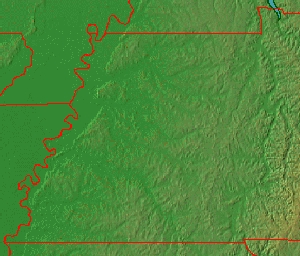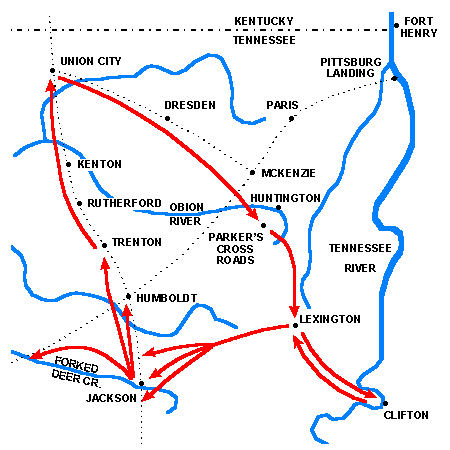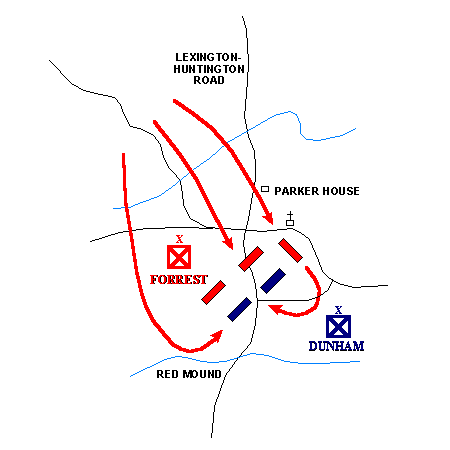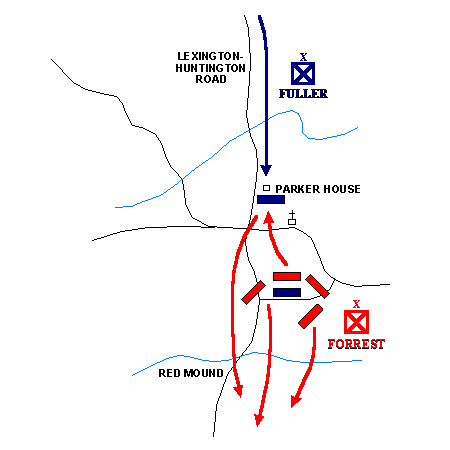FORREST'S
Cavalry Raid
(2 December - 2 January 1863)
"Forrest is crossing the Tennessee River at Clifton "
-- Union commander in Tennessee, understated dispatch to General Ulysses S. Grant, 15 December 1861
"I have Forrest in a tight place. My troops are moving on him from three directions, and I hope with success."
-- Briagadier General Jeremiah Sullivan, dispatch to General Ulysses S. Grant prior to the Battle of Parker's Cross Roads, 29 December 1862.
We drove them through the woods with great slaughter and several white flags were raised in various portions of the woods and the killed and wounded were strewn over the ground."
-- Briagadier General Nathan Bedford Forrest, following the defeat of the Federals behind the rail fence at Parker's Cross Roads, 31 December 1862.
"Charge them both ways!"
-- Briagdier General Nathan Bedford Forrest, upon being surprised by an attack from behind at Parker's Cross Roads, 31 December 1862.
Principal Commanders
Union:
Brig. Gen. Jeremiah "Jere" Sullivan
Colonel Robert G. Ingersoll
Colonel Cyrus L. Dunham
Colonel John W. Fuller
Colonel Jacob Fry
| |
Confederate:
Brig. Gen. Nathan Bedford Forrest
Colonel George G. Dibrell
Colonel A. A. Russell
Colonel James W. Starnes
|
| |
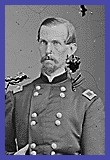
Sullivan |

Fuller |
|
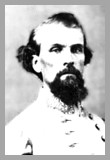
Forrest |
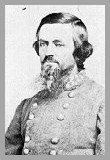
Dibrell |
Physical Features
Brigadier General Nathan Bedford Forrest had been ordered to strike the Union supply lines in western Tennessee. Gently rolling hillsides dotted with low knolls characterize the region. Meandering streams cut the landscape, flowing primarily westward toward the the broad alluvial plain of the Mississippi River, though some flowed eastward into the more severly-cut Tennessee River. Forrest's Raids would be roughly framed within the borders of those two rivers. As gentle as the countryside seemed, it would be no simple task for Forrest -- it was winter and the area contained many poor roads.
Description of the Raid
Forrest knew full well the task that had been placed before him. He knew that when he crossed the Tennessee and stuck, he would be hounded by Federal forces at every turn. Forrest was not new to this type of fighting, but his command was made up entirely of new recruits, half of whom were so badly armed that they were of no value in a fight. Undaunted, he prepared them by infusing them with a sense of urgency. With usual common sense, he prepared logistically, sending a team of men forward from where he was stationed in Columbia, to build rafts for crossing the Tennessee River.
On 2 December 1862 he crossed the Tennessee with about 2,500 men, sinking the rafts in shallow water so they could be retrieved upon their return. Their first engagment was at Lexington 18 December, where they ran into 800 Federal Cavalry under the command of Colonel Robert G. Ingersoll, who had been sent out from Jackson to confront Forrest. Ingersoll's men broke, leaving behind not only 147 men, weapons, and amunition, but their Colonel as well. Panic was already beginning to spread through the region. But Forrest did not linger at Lexington. Knowing full well the urgency of the situation, he quickly pressed on to Jackson.
At Jackson were 10,000 Federals under Brigadier General Jeremiah Sullivan. But stragglers from Ingersoll's command exaggerated Forrest's numbers, and Forrest himself did all he could to "keep up the skeer," as he called his elaborate diversionary tactics. Constantly beating drums, lighting numerous fires, moving artillery from one point to another and then back again, dismounting cavalry and parading them as infantry, parolling prisoners who had been fed carefully crafted intelligence reports -- were all deceptions employed by Forrest through the war. His demonstrations paid handsome dividends at Jackson as Sullivan, instead of confronting Forrest, pulled back and concentrated all his forces at Jackson. It was more than Forrest could have asked for, because it left him free to roam the surrounding countryside and wreck the railroad, which had been his prime directive. At Jackson, he came up with a plan to accomplish just that.
On 19 December, Forrest attacked Sullivan at Jackson. But it was only a feint and he never intended to take the town. He had detached two commands under Colonel George G. Dibrell to head north and attack the depot and railway at Carrol Station. Meanwhile, Colonel A. A. Russell sped south and west to disrupt the railway that led to Corinth and Bolivar. The operations were successful as Dibrell systematically destroyed the post and the rail line, capturing 101 prisoners as well as new rifles the men could use. Russell burned bridges and dismantled rail lines without resistance. Meanwhile, Forrest fared better than expected. Hoping only to hold the Federals, he instead drove them back into their fortifications. When Sullivan came out the next day to press the attack, Forrest was already gone, having left only a thin line of skirmishers as cover.
Forrest was already racing north. Speed was of the essense, and he divided his command again to inflict the maximum damage. Dibrell was to capture the bridge at Forked Deer Creek, Colonel James W. Starnes would assault Humbolt, while Forrest would strike Trenton. Starnes had the easiset time, burning the bridge and depot, and destroying supplies he could not carry. Trenton, however, was well-garrisoned under Union Colonel Jacob Fry with 700 men, and Forrest faced a stubborn resistance. The initial charge emptied too many saddles for Forrest's liking, who instead surrounded the garrison and brought up his artillery to pound it to submission. After three rounds, Fry surrendered his command. Dibrell faired poorly, though through no fault of his own. By the time he reached Forked Deer Creek, reinforcements had arrived under Colonel John W. Fuller. He could do little but demonstrate against them in order to give other detachments time to attack their targets, and then withdrew. Fuller joined up with Sullivan at Jackson, but would come back to haunt Forrest.
The next morning, Forrest moved toward Union City. Along the way, Dibrell and Starnes joined him. They destroyed bridges and rails at Rutherford Station, Kenton Station, and over the Obion River. Arriving at Union City, they had no sooner made an appearance than the Federal garrison surrendered. Arriving as far north as Forrest had intended to go, he turned southeast, causing additional destruction at Dresden and McKenzie. But he was also heading toward a danger of which he was unaware, one that could annihilate his army and undo all the good he had accomplished.
Sullivan and his two brigades under Fuller and Colonel Cyrus L. Dunham was hot on Forrest's heels. Ahead, they had destroyed the bridge over a rising Obion River, hoping to trap Forrest. But the tenacious southern cavalryman was not one to panic easily, and discovered another bridge, albeit a poor one. The Federals had thought it too unsound to cross, but they were wrong. Forrest immediatly set about repairing it, even joining in the work. When it was finished, he crossed first, and his command easily escaped the Federal trap, making their way to Flake's Store on the McLemoresville Road, four miles northwest of Parker's Crossroads. But the Federal force, led by Sullivan's advance brigade under Dunham was bearing down on him. Forrest now knew the enemy was too close to allow a safe crossing of the Tennessee River into home territory. He elected instead to fight the enemy at Parker's Cross Roads.
On 31 December, Dunham had arrived with his brigade at Parker's Cross Roads. Chasing off Confederate skirmishers at about 9:00 am, he deployed his brigade into line of battle at Hick Field, one mile northwest of Parker's Cross Roads. Blocking the way south, he sent word to Sullivan and Fuller, then waited for Forrest to arrive. He did not have long to wait. Forrest had placed several companies at Huntington to warn him of a rear attack, and then threw his artillery against Dunham on the northwest perimeter of Hick Field. After a brief duel, Dunham withdrew south past the Parker House.
Dunham anchored his left flank near the community of Red Mound, transecting the Huntington-Lexington Road. His new position continued blocking the road south, and he desperately hoped the remainder of Sullivan's force would arrive soon. Forrest pressed on, attempting to win the battle with artillery. It performed admirably and they drove the Federals before them. Dunham took up position behind a rail fence, hoping it would offer protection, but it did just the opposite. The artillery barrage splintered pieces of the fence, turning it into deadly shards. Numerous times the Federals charged the Confederate line, but were repulsed. Forrest then employed a double-flanking movement combined with an attack on Dunham's rear with mounted and unmounted cavalry. Dunham turned most of his brigade to the new threat from behind and soon found himself surrounded.
The battle seemed won. Forrest sent word for Dunham to surrender, but the Union Colonel refused. As Forrest was preparing to renew the attack, Union soldiers suddenly appeared behind him. His Huntington rearguard had failed Forrest; Fuller's brigade had arrived at the Parker House as Forrest was negotiating with Dunham. Fuller descended on the horse-handlers near the Parker House and almost 300 of Forrest's dismounted cavalry were captured as they raced to their scattered horses.
Forrest rode back personally to appraise the situation and rode right into the Federal line, close enough for Union soldiers to order him to surrender. In typical fashion, he replied he had already done so and would go back to get what was left of his men. The scrapy general then wheeled his horse and raced off under a hail of fire. When he reached his lines, an excited officer asked what to do and Forrest was said to have ordered to attack in both directions. He may or may not have said it, but thats exactly what his commanders did. Russell and Starnes attacked Duham's demoralized force, while Forrest regrouped what he had -- about 75 men -- and charged Fuller's artillery, scattering the cannoneers and the supporting infantry. Then racing back to join Russell and Starnes, they rode hell bent for leather through Dunham's command to safety.
Forrest rested his cavalry briefly at Lexington. On 1 January 1863 he reached the Tennessee River, and defeated a small cavalry force attempting to prevent him from crossing the river. Forrest's weary cavaly crossed the river on the rafts they had sunk earlier, and their stunningly successful Tennessee Raid was over.
Results
- Confederate victories at Lexington and Parker's Cross Roads (both sides claimed victory at Parker's Cross Roads, but Confederate claims held more credance).
- Confederate skirmishes at bridges, depots, and garrisons throughout western Tennessee were all successful, except for Forked Deer Creek.
- Forrest not only disrupted over sixty miles of vital rail line, but caused chaos even in areas he never intended to attack. One Union General -- Thomas A. Davies -- ordered his troops at Island No. 10 and New Madrid to spike their guns and dump powder in the river to prevent them from falling into Forrest's hands. He even boasted to Grant that by his actions, Forrest had been " ... richly paid for his temerity and boldness." Grants reaction could only have been "Huh?" But this was the nature of panic that the very mention of Forrest's name elicited.
- Sullivan informed Grant that Forrest's cavalry was " ... completely broken up. They are scattered over the country without ammuninition." The report was a lie, and it is not known if Grant believed it or not. But it didn't matter. Grant was just happy to be rid of Forrest ... for now. Forrest was by no means broken, though his troops were weary. They rested and refitted during January in Columbia and returned to action soon thereafter, to raise havoc once again.
Statistics
| Army | Lexington | Parker's Cross Roads |
|---|
| Effectives | Casualties | Effectives | Casualties |
|---|
| Union |
800 |
6 |
3,000 |
237 |
| Confederate |
2,500 |
? |
2,500 |
500 |
| Total |
3,300 |
? |
5,500 |
737 |
Additional notes, interesting incidents, and fate of the principals
- Along with the capture of Ingersoll at the Battle of Lexington, were two three-inch Rodman guns which Forrest gave to his young artilleryman Lieutenent John Morton. When Morton first came to Forrest's command, neither Forrest nor Morton were pleased. Forrest remarked that , "I'd like to know why in the hell Bragg sent that tallow-faced boy here to take charge of my artillery?" Forrest already had an artillery commander in Captain Freeman. But Freeman generously lent the young Lieutenant two artillery pieces, which Morton returned after receiving the Rodmans. These guns became the nucleus around which Morton would build an exceptional cavalry battery, quickly earning the respect and admiration of his commander. Morton would serve Forrest with distinction throughout the war.
- Forrest's overly combative nature served him well in battle, but often led to clashes with his subordinates and superiors alike. He attempted to transfer Brigadier General James R. Chalmers out of his command, and although a personal friend of Lieutenant General Joseph Wheeler, promised to be in his coffin before he would ever serve under him again. He very nearly engaged in a saber duel with Major General Earl Van Dorn, and in his stormiest confrontation, denounced even Full General Braxton Bragg himself. Shaking his finger at the commander of the Army of Tennessee he exclaimed, "You have played the part of a damned scoundrel, and are a coward, and if you were any part a man I would slap your jaws and force you to resent it." The only commanders Forrest seemed to do well under were those who allowed him a high degree of autonomy. By the end of the war, he had thirty horses shot out from under him while killing thirty-one men in hand-to-hand combat. "I was a horse ahead at the end," he was fond of saying.
- The quick surrender of the garrison at Union City became an issue and highlighted Forrest's unsophisticated and straightforward approach to war. He had sent foward the prisoners he had captured at Trenton, to be exchanged at Union City. The commander there, Captain Samuel B. Logan, was still under the first flag of truce receiving the parolees, when Forrest arrived with his entire force and sent a second flag of truce ordering his surrender. Logan contended that the first flag had been used to gain an advantage over him. After all, Forrest was approaching Union City, and still had sent the prisoners ahead to be exchanged. Did he wish to capture and exchange them again? Logan may have been simply trying to buy time, and a West Point graduate may have conceded the point, but this was no West Pointer Logan faced. He was dealing with Forrest, who brushed the complaint aside and saw no connection between the two flags of truce. He demanded an immediate and unconditional surrender of the garrison. There was nothing for Logan to do but surrender to the ever-practical Forrest.
Sources:
- Faust, Patricia, L., ed. Historical Times Illustrated Encyclopedia of the Civil War. 1986.
- Foote, Shelby. The Civil War, A Narrative. 1986.
- Long, E.B., and Long, Barabara, eds. The Civil War Day by Day. 1971.
- McPherson, James M., ed. The Atlas of the Civil War. 1994.
- Wills, Brian Steele. A Battle from the Start, The Life of Nathan Bedford Forrest. 1992.
On the Internet:
- Battlefields in Western Tennessee
- The Battle of Parker's Cross Roads
 |
Return to
Vicksburg |




